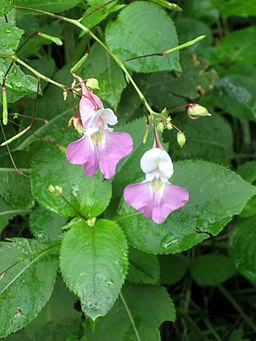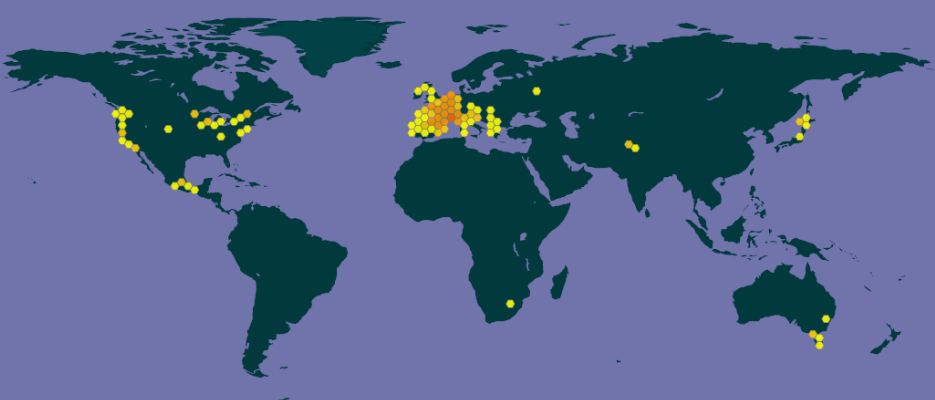 |
Balfour’s touch-me-not, Kashmir balsam | Status LU: casual. 1st record: LU <1995, ITW 2016. |
 |
Balfour-Sprangkraut | Status Eur.: established. 1st record: FR ~1890.1 |
 |
Impatiente, balsamine de Balfour | RA: ISEIA: B1 – Watch List. Harmonia+: 0,09. |
 |
Balfour’s Springkraut | Wikipedia:   | Wikispecies: | Wikispecies:  | CABI | CABI |
 |
Tweekleurig springzaad | Back to the list of neophytes |
Contents
Report the species
→ Report Impatiens balfourii to the National Museum of Natural History.
Brief description
 Impatiens balfourii Hook.f. is a species of the genus Impatiens known by the common names Balfour’s touch-me-not, Kashmir balsam, and Poor Man’s Orchid. It belongs to the family Balsaminaceae. It is native to the Himalayas, particularly Kashmir and surrounding areas, where it grows on mountains of 5,000 to 6,000 feet. It was brought back to England and many other European countries as a garden plant. It can now be found growing wild as a garden escapee in Europe. In the wild the plant occurs along the banks of rivers, on roadsides, and in wastelands. It thrives in cool and moist areas, at an altitude of 100–600 m above sea level (Wikipedia contributors 2019).
Impatiens balfourii Hook.f. is a species of the genus Impatiens known by the common names Balfour’s touch-me-not, Kashmir balsam, and Poor Man’s Orchid. It belongs to the family Balsaminaceae. It is native to the Himalayas, particularly Kashmir and surrounding areas, where it grows on mountains of 5,000 to 6,000 feet. It was brought back to England and many other European countries as a garden plant. It can now be found growing wild as a garden escapee in Europe. In the wild the plant occurs along the banks of rivers, on roadsides, and in wastelands. It thrives in cool and moist areas, at an altitude of 100–600 m above sea level (Wikipedia contributors 2019).
Status and distribution in Luxembourg
Records of Impatiens balfourii Hook.f. in Luxembourg. Data source: Recorder-Lux, iNaturalist & GBIF, 2024-10-22.
In Luxembourg, Impatiens balfourii Hook.f. was first observed in 2009 in the Mediterranian Garden in Schwebsange, when “Natur & Ëmwelt Fondatioun Hëllef fir d’Natur” took over the management of the premises. The former owners recalled having brought the species from a trip to Lago Maggiore in Northern Italy in the late 1980ies or early 1990ies (Moes 2021). We thus assume the 1st record of the species is to be dated before 1995.
The species was first observed in the wild by Roland Proess on 2016-08-05 at Schëttermarjal on the edge of the Kirchberg plateau in Luxembourg City (Krippel & Proess 2017). The species is at present considered to be subspontaneous; it may however have the potential of becoming naturalised in Luxembourg due to climate change (Krippel & Proess 2017).
A second observation of this melliferous Himalayan species was made on 2020-08-28 on a ruderal stand next to a stone wall in Neudorf (MNHNL, iNaturalist & GBIF 2021).
Cultivated as an ornamental garden plant. Found subspontaneously here and there, or sometimes naturalised locally, especially in the south (Lambinon & Verloove 2012: 480).
Impatiens balfourii has its origins in the west Himalayan region (Grey-Wilson 1983). This species of the Balsaminaceae family was simultaneously introduced in 1901 at the Jardin des plantes de Montpellier and the Botanical Garden of Edinburgh (Adamowski 2009). It has been cultivated in Europe as an ornamental plant since the beginning of the 20th century; in Luxembourg it is grown, for example, in the Jardin méditerranéen in Schwebsange. Nowadays the species is naturalised in major parts of south and central Europe (Adamowski 2009, Schmitz & Dericks 2010).
Alien Impatiens taxa
Six alien balsam species have been reported in Luxembourg, Impatiens noli-tangere L. being the only native species.
- Impatiens balfourii Hook.f.: Balfour’s touch-me-not, first observed in 2016 in the wild in Luxembourg.
- Impatiens balsamina L.: the garden balsam is already mentioned in Krombach’s flora of 1875 as “Introduced from the East Indies and grown in all gardens” (Krombach 1875: 56).
- Impatiens capensis Meerb. is an annual plant native to eastern North America that is currently spreading across Europe. In Luxembourg, it was first reported on 2021-10-11 from the Moselle valley.
- Impatiens glandulifera Royle: the invasive Himalayan Balsam, which is widespread in riparian ecosystems and forests across Luxembourg.
- Impatiens parviflora DC.: the small balsam, which is widespread in forests across Luxembourg.
- Impatiens walleriana Hopok. f. was reported once as cultivated in Rumelange in 1946.
In 2011 the annual hybrid Impatiens parviflora × I. balfourii was discovered in the canton of Ticino in Switzerland. The fertile hybrid with alternating leaves can be up to 60 cm high. Considerable populations of the hybrid were observed in 2014 in the canton of Ticino in the absence of the parent species (Van Valkenburg et al. 2019).
Risk assessment
ISEIA protocol
B1 (3+3+3+1) = Watch List. First assessed 16 February 2017 by Yves Krippel and Christian Ries.
Harmonia+ protocol
Overall risk score 0,09 = (Overall Invasion score 0,17 x Overall Impact score 0,30) (Ries et al. 2020).
 Invasion
Invasion0,30

 Impact
Impact0,09

 Risk
RiskWorldwide distribution
Bibliography
- Adamowski, W., 2009. Impatiens balfourii as an emerging invader in Europe. Neobiota 8: 183-194.
- CABI, 2019. Impatiens balfourii. In: Invasive Species Compendium. Wallingford, UK: CAB International. URL: www.cabi.org/isc [accessed 2020-03-02]
- GBIF, 2020. Impatiens balfourii Hook.f. in GBIF Secretariat (2019). GBIF Backbone Taxonomy. Checklist dataset https://doi.org/10.15468/39omei [accessed 2020-03-02]
- Grey-Wilson, C., 1983. A survey of the genus Impatiens in cultivation. The Plantsman 5(2): 86-102.
- Krippel, Y. & R. Proess, 2017. Impatiens balfourii Hook.f. (Balsaminaceae), nouvelle espèce subspontanée au Luxembourg ?! Bull. Soc. Nat. luxemb. 119: 55-61 [PDF].
- Lambinon J. & F. Verloove, 2012. Nouvelle flore de la Belgique, du grand-duché de Luxembourg, du Nord de la France et des régions voisines. Sixième édition. Avec la collaboration de L. Delvosalle, B. Toussaint, D. Geerinck, I. Hoste, F. Van Rossum, B. Cornier, R. Schumacker, A. Vanderpoorten et H. Vannerom. Jardin botanique national de Belgique, Meise. CXXXIX + 1195 pp. ISBN : 9789072619884.
- Matthews, J., R. Beringen, E. Boer, H. Duistermaat, B. Odé, J. L. C. H. van Valkenburg, G. van der Velde & R. S. E. W. Leuven, 2015. Risks and management of non-native Impatiens species in the Netherlands. Ed. by Radboud University, FLORON and Naturalis Biodiversity Center, Reports Environmental Science 491, 2015. 177 S. [PDF]
- MNHNL, 2000-. Impatiens balfourii Hook.f. in Recorder-Lux, database on the natural heritage of the Grand Duchy of Luxembourg. Musée national d’histoire naturelle, Luxembourg. URL: https://mdata.mnhn.lu [Accessed 2019-10-11]
- MNHNL, iNaturalist & GBIF, 2021. Impatiens balfourii Hook.f. in MNHNL-mdata, online portal combining species observation from Recorder-Lux, iNaturalist and GBIF. National Museum of Natural History, Luxembourg. URL: https://mdata.mnhn.lu [Accessed 2021-01-12]
- Moes, G., 2021. Personal communication by E-mail to Yves Krippel on 2021-01-09.
- Ries, C. & Y. Krippel, 2021. First records of 56 invasive alien vascular plants in Luxembourg. Bulletin de la Société des naturalistes luxembourgeois 123: 115-127. [PDF 241 KB]
- Ries, C., Y. Krippel & M. Pfeiffenschneider, 2020. Risk assessment after the Harmonia+ protocol of invasive alien vascular plant species in Luxembourg. Bull. Soc. Nat. luxemb. 122: 197-205. [PDF 132 KB]
- Schmitz, U. & G. Dericks, 2010. Spread of alien invasive Impatiens balfourii in Europe and its temperature, light and soil moisture demands. Flora 205: 772-776.
- Van Valkenburg, J. L. C. H., N. Schoenenberger, B. T. L. H. van de Vossenberg, W. A. Man in’t Veld, M. Westenberg & E. Boer, 2019. A natural hybrid of Impatiens, in the introduced range, demonstrated by sequence analysis of the nuclear ribosomal DNA-gene repeat. Botany Letters 166: 144-152.
- Wikipedia contributors, 2019. Impatiens balfourii Hook.f. in Wikipedia, The Free Encyclopedia, 22 September 2019, 14:49 UTC, <https://en.wikipedia.org/w/index.php?title=Impatiens_balfourii&oldid=917160050> [accessed 2019-10-11]
Suggested citation of this webpage
Ries, C., M. Pfeiffenschneider & Y. Krippel (Eds.), 2024. Impatiens balfourii Hook.f. In: neobiota.lu - Invasive Alien Species in Luxembourg. National Museum of Natural History, Luxembourg. URL: https://neobiota.lu/impatiens-balfourii/ [Accessed 2024-10-22].
Page content last updated on 2021-12-10. Last proofread by Caroline Grounds on 2019-11-19.
- Cf. Matthews et al. 2015: 46.[↩]


